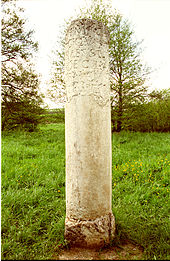
The Great Saint Martin Church is a Romanesque Catholic church in Cologne, Germany. Its foundations rest on remnants of a Roman chapel, built on what was then an island in the Rhine. The church was later transformed into a Benedictine monastery. The current buildings, including a soaring crossing tower that is a landmark of Cologne's Old Town, were erected between 1150-1250. The architecture of its eastern end forms a triconch or trefoil plan, consisting of three apses around the crossing, similar to that at St. Maria im Kapitol. The church was badly damaged in World War II; restoration work was completed in 1985.
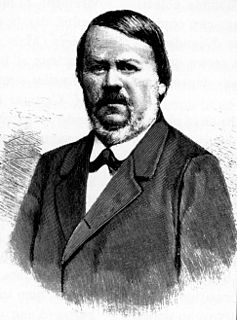
Hermann Schaaffhausen was a German anatomist, anthropologist, and paleoanthropologist.

Stockstadt am Main is a market community in the Aschaffenburg district in the Regierungsbezirk of Lower Franconia (Unterfranken) in Bavaria, Germany.
Franz Xaver Kraus was a German Catholic priest, and ecclesiastical and art historian.
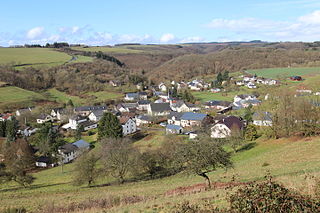
Utscheid is a municipality in the district of Bitburg-Prüm, in Rhineland-Palatinate, western Germany.
Johannes Mötsch is a German archivist and historian.

The Römisch-Germanisches Zentralmuseum (RGZM), Leibniz Research Institute for Archaeology, is headquartered in Mainz. It is supported by the Federal Republic of Germany and its states and is a member of the Leibniz Association of German research institutions.

Meister or Master Gerhard was the first master mason of Cologne Cathedral. He was also known as Gerhard von Rile or by the Latin version of his name, Meister Gerardus.
The Rudolf Virchow lecture was an annual public lecture delivered by an eminent researcher in the field of Palaeolithic archaeology in Neuwied (Germany). The lecture was held in honour of the German physician, archaeologist and politician Rudolf Virchow and his contributions to German archaeology, whilst at the same time also honouring the outstanding accomplishments of the invited speaker. The lecture series was discontinued after 2016, when a new price, THE HUMAN ROOTS AWARD was established to recognise significant achievements that have had an outstanding impact or great influence in understanding the archaeology of human behavioural evolution.

The archaeological site Niederbieber is an important representative of the Federmesser culture. Dating to the end of the Pleistocene, the site is one of the most extensively excavated archaeological sites dating to the late Upper Palaeolithic. Finds and features are extraordinarily well preserved as the site was protected by fallout from the Laacher See volcanic eruption approximately 12,900 years ago. Comprehensive archaeological studies have provided a detailed view of activities and settlement dynamics of hunter-gatherer groups at the end of the ice age.

The Schelenburg is a water castle in Schledehausen, municipality of Bissendorf, Lower Saxony.

The Rheinische Landesmuseum Trier is an archaeological museum in Trier, Germany. The collection stretches from prehistory through the Roman period, the Middle Ages to the Baroque era with a strong emphasis on the Roman past of Augusta Treverorum, Germany's oldest city. Its collections of (local) Roman sculptures, Roman mosaics and frescos are among the best in Germany.
Michael Matheus is a German historian.

Hermann Parzinger is a German historian who is a specialist in the culture of the Scythians. He has been president of the Prussian Cultural Heritage Foundation since 1 March 2008.

The Lower Germanic Limes is the former frontier between the Roman province of Germania inferior and Germania Magna. The Lower Germanic Limes separated that part of the Rhineland left of the Rhine as well as the Netherlands, which was part of the Roman Empire, from the less tightly controlled regions east of the Rhine.
The Vogelheimer Klinge is an approximately 280,000 year old flint tool, discovered in 1926 during the construction of the Rhine-Herne Canal in Vogelheim, north of the city of Essen. In older publications it is also known as the Klingenschaber von Vogelheim. It was long considered to be the oldest accurately dated artifact in North Rhine-Westphalia and can be found in the de:Ruhr Museum.
The Main Limes, also called the Nasser Limes, was built around 90 A. D. and, as part of the Upper Germanic-Rhaetian Limes, formed the frontier of the Roman Empire in the area between the present day villages of Großkrotzenburg and Bürgstadt. In this section the limes adjoined the River Main (Moenus), which forms a natural boundary for about 50 kilometres here, so "Main" refers to the river.
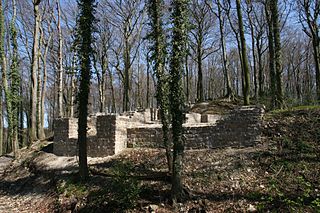
The Holter Burg is the oldest castle site in the municipality of Bissendorf near Osnabrück in the German state of Lower Saxony. It is the ruin of a hill castle. It was the third hill castle in Osnabrück Land along with the Iburg and the Wittekindsburg near Rulle.

The Wetterau Limes is the name given in the field of historical research to that part of the Upper Germanic-Rhaetian Limes which enclosed the region that became known later as the Wetterau in the German state of Hesse.
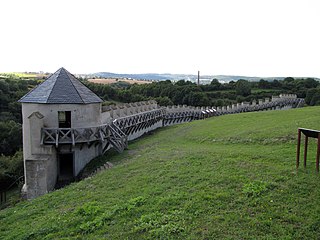
Katzenberg Hillfort is a Roman refuge fort near Mayen in Germany dating to the 4th century.




